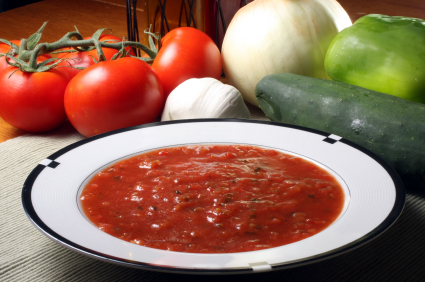 Spanish steps to the perfect summer soup.Like Penelope Cruz, my restaurant has a Spanish accent. I can’t quite say “theme,” because the menu is far from 100 percent Spanish; but we focus on tapas and serve classic preperations like paella and sangria. This time of year, our Spanish lilt mandates gazpacho.
Spanish steps to the perfect summer soup.Like Penelope Cruz, my restaurant has a Spanish accent. I can’t quite say “theme,” because the menu is far from 100 percent Spanish; but we focus on tapas and serve classic preperations like paella and sangria. This time of year, our Spanish lilt mandates gazpacho.
Some of the best dishes in the world were invented via that great mother, necessity: the necessity to get by on very little, or to make use of a soon-to-spoil abundance. Witness cassoulet, prosciutto, gumbo, quiche, bouillabaisse, pesto, etc. Gazpacho falls on the abundance side of that truism, as it makes use of just about everything that is ripe and abundant in my restaurant Devotay’s gardens right now.
Originating in Andalusia, the southern part of Spain that includes Gibraltar, the soup most Americans know is probably not the original. When most of Spain was part of the Moorish empire, cooks there developed an ancestor of the now-familiar gazpacho made of garlic, almonds, bread, olive oil, vinegar, and salt. Now called ajo blanco, this was the go-to cold soup in Spain until Columbus returned with from the new world with the curious nightshade, the tomato, one of many New World foods destined to revolutionize world cuisine.
 Gazpacho: Southern Spain in a bowl. Today’s most common version contains two new world foods, the tomato and the pepper. The ultimate summer soup, gazpacho also makes an interesting drink when used like a Blood Mary mix (omit the bread from the recipe below for that).
Gazpacho: Southern Spain in a bowl. Today’s most common version contains two new world foods, the tomato and the pepper. The ultimate summer soup, gazpacho also makes an interesting drink when used like a Blood Mary mix (omit the bread from the recipe below for that).
Iowa is renowned for its ungodly hot and humid weather in July and August, and even though we’ve seen an uncharacteristically cool summer thus far, the gazpacho still sells well. We get a lot of vegetarian guests since the menu is about 65 percent veggie, and this dish can be made perfect for the stricter vegans, simply by leaving out the chopped egg garnish.
Gazpacho Andaluz
Andalusia is the region of Spain where Jerez, the home of sherry, is located. Sherry is a nice accompaniment to Spain’s most famous soup. Look for a sherry called “Amontillado,” which refers to the medium-dry character of the wine. I like the Gomez or Wisdom & Werter brands.
3 pounds tomatoes — peeled, seeded and diced (see below)
1 onion diced
2 green peppers cored and diced
2 roasted red peppers
4 cloves garlic
4 slices day-old bread, cubed, crusts removed
2 1/2 cups tomato juice
6 tablespoons extra virgin olive oil
4 tablespoons red wine vinegar
Salt and pepper to taste,
at service
Ice cubes
1 red and 1 green bell pepper, minced
1 onion, minced
2 hard-boiled eggs, minced
2 cups croutons
To peel the tomatoes, use a sharp knife to make an X on the bottom. Plunge them into boiling, salted water for 30 to 45 seconds, or until the skin becomes loose. Immediately “shock” them by placing them in ice water. When they are cool enough to handle (usually just a minute) use the knife to peel the loosened skins away. To seed the tomatoes, cut them in half along the equator and gently squeeze the seeds into a strainer over the sink. Rinse and dry the seeds and save them for next year’s garden.
Now puree the peeled, seeded tomatoes in a blender or food processor along with the onion, peppers, garlic, bread, tomato juice, olive oil and vinegar. You may need to do this in batches. Season to taste with salt and fresh cracked black pepper, then serve, garnished with an ice cube, pinches of the minced peppers and eggs, and a few croutons.



